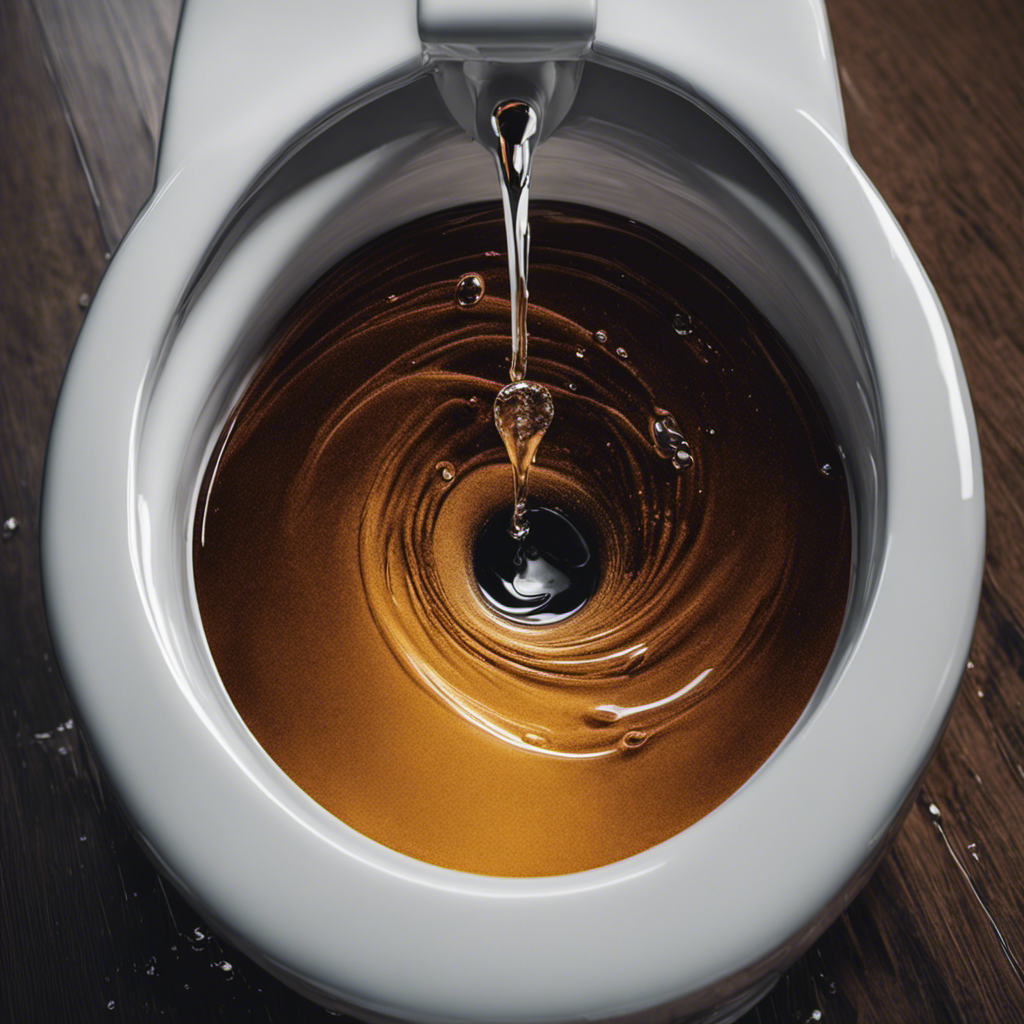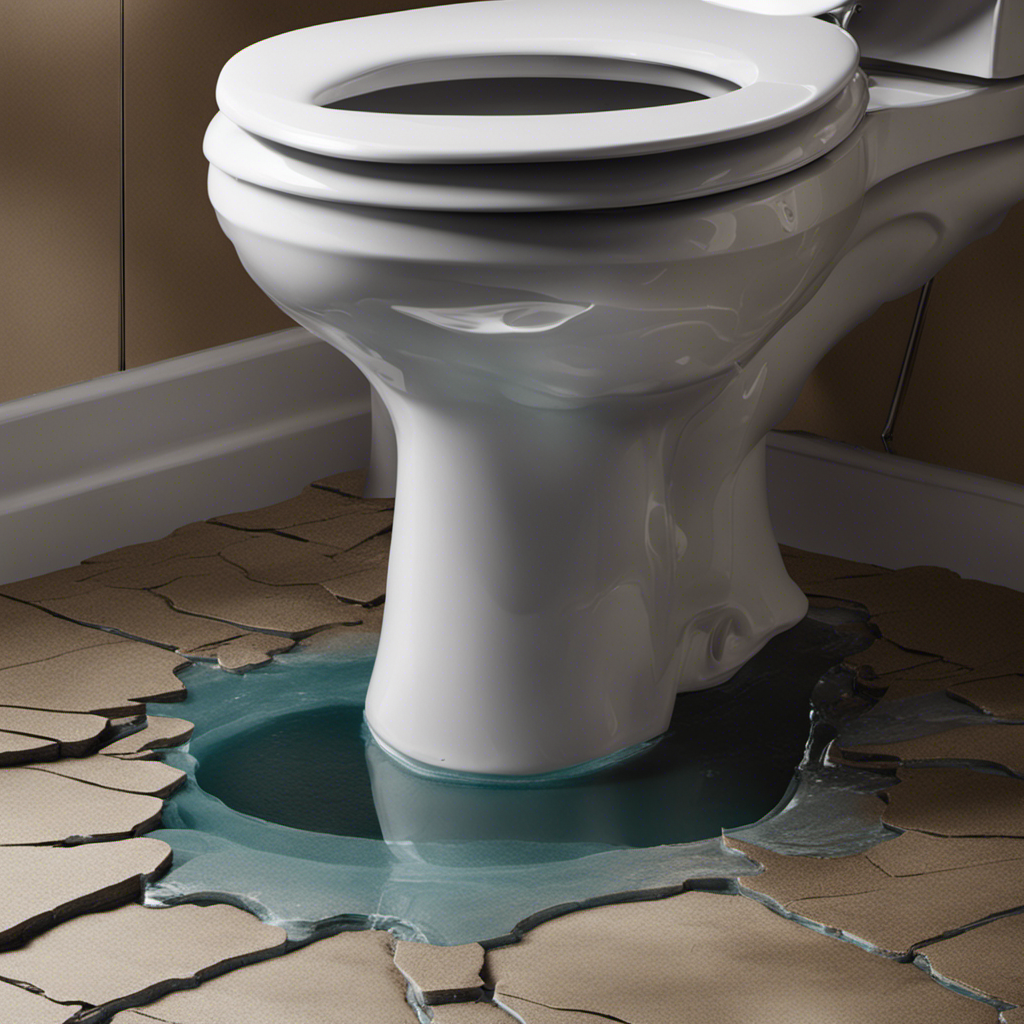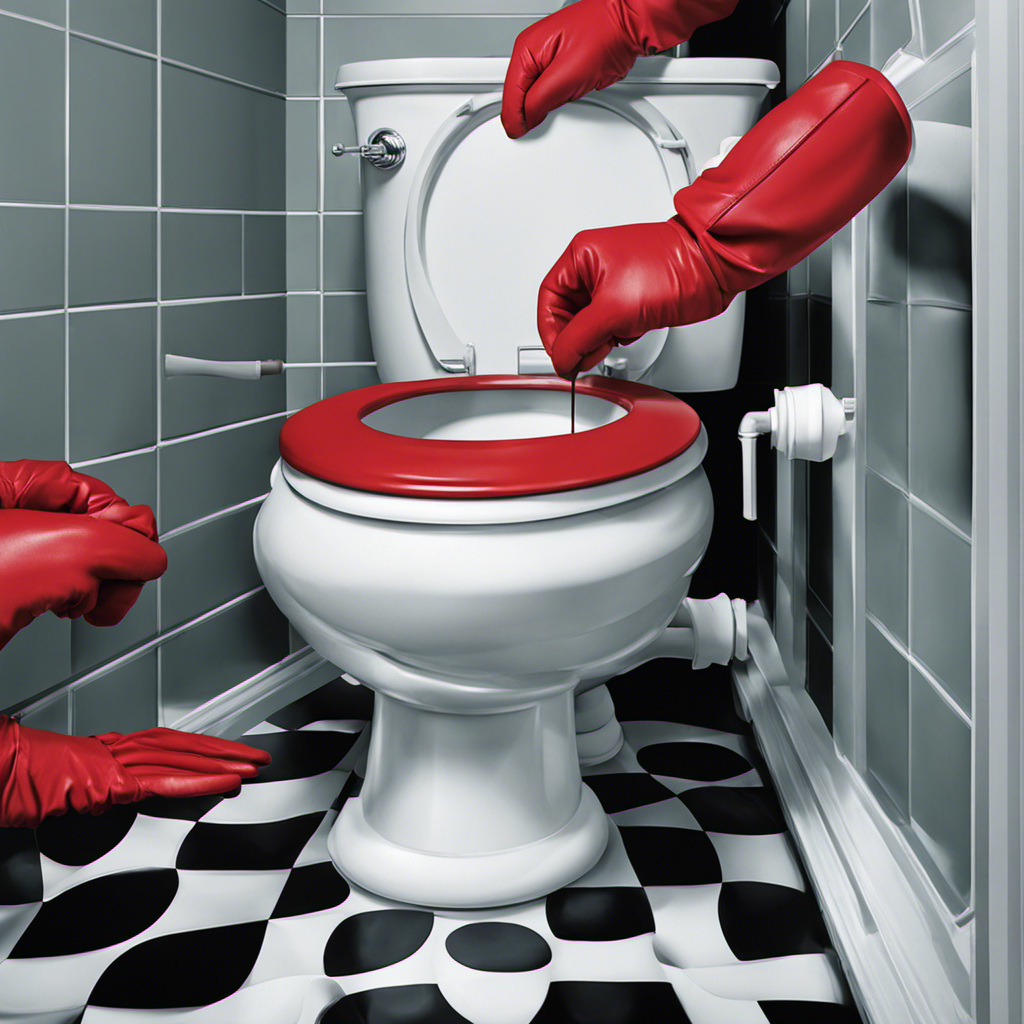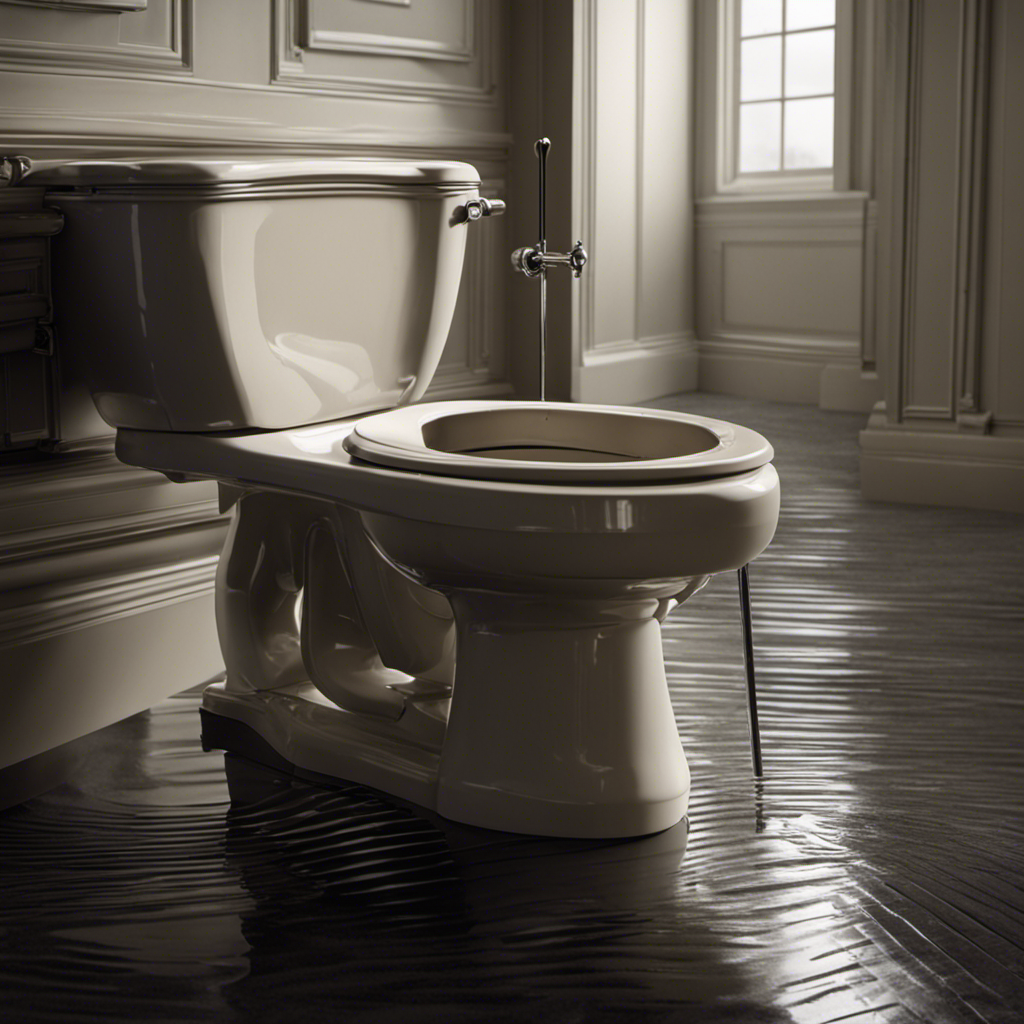Leaky toilets can be a troublesome issue, causing frustration and potential water damage. As a plumbing specialist, I understand the importance of addressing these problems promptly.
In this article, I will guide you through the common causes of toilet leaks when flushed, how to identify them, and provide step-by-step solutions to fix them. By following these expert tips, you can prevent future leaks and maintain a properly functioning toilet.
Let’s dive into the world of toilet troubleshooting and find practical solutions together.
Key Takeaways
- Faulty flapper valve is a common cause of toilet leaks when flushed, and it can be resolved by replacing the faulty valve.
- Regular maintenance and inspection are important to identify and detect toilet leaks, such as water pooling around the base of the toilet or a constantly running toilet.
- DIY fixes for toilet leaks include checking and replacing the flapper valve, inspecting and adjusting or replacing the fill valve, and turning off the water supply before attempting repairs.
- Calling a professional plumber is necessary for complex problems or when DIY attempts fail, as they can provide accurate diagnosis and effective solutions.
Common Causes of Toilet Leaks
One of the most common causes of toilet leaks is a faulty flapper valve. The flapper valve is responsible for controlling the flow of water from the tank to the bowl when you flush the toilet.
Over time, the flapper valve can deteriorate or become misaligned, resulting in water continuously leaking from the tank into the bowl. This constant leakage not only wastes water but can also lead to higher water bills.
To repair a toilet leak caused by a faulty flapper valve, you will need to replace the valve with a new one. Ensure that the replacement flapper valve is compatible with your toilet model. By addressing this issue, you can prevent further water wastage.
Now let’s move on to how to identify a leaking toilet.
How to Identify a Leaking Toilet
As a plumbing specialist, I’ve encountered numerous cases of toilet leaks when flushed. I understand the importance of identifying and addressing them promptly.
In this discussion, I’ll cover the common warning signs that indicate a leaking toilet. I’ll also provide a step-by-step guide for DIY leak detection.
Common Warning Signs
If your toilet leaks when flushed, there are common warning signs to watch out for. These signs can help you identify the problem early and prevent further damage.
Here are some common warning signs to look for:
- Water pooling around the base of the toilet
- Constantly running toilet
- Decreased water pressure in other fixtures
- Mold or mildew growth near the toilet
These warning signs indicate potential causes of water damage, such as a faulty flapper valve, worn-out seals, or a cracked toilet bowl.
Regular maintenance is crucial to prevent these issues. It is important to check for any leaks or abnormalities regularly. Additionally, performing routine maintenance tasks like replacing worn-out parts and inspecting the toilet’s components can help identify and address potential problems before they escalate.
DIY Leak Detection
You can easily detect leaks in your bathroom by checking for water pooling around the base of the toilet. If you notice this issue, it is crucial to take immediate action to prevent further damage and ensure the optimal functioning of your toilet.
One common cause of toilet leaks when flushed is a faulty wax ring. This ring seals the connection between the toilet base and the floor drain. Over time, the wax ring can deteriorate or become misaligned, leading to leaks. To repair this issue, you will need to replace the wax ring.
Another possible cause is a cracked toilet bowl or tank. In this case, the only solution is to replace the entire toilet.
To prevent toilet leaks, regularly inspect the wax ring and ensure it is in good condition. Additionally, avoid using excessive force when flushing the toilet, as it can cause damage to the internal components.
DIY Fixes for Toilet Leaks
There’s a simple DIY fix for toilet leaks that you can try. Toilet leaks when flushed can be caused by various factors, but don’t worry, I’ll guide you through the process of identifying and repairing the issue.
Here are the steps you can follow:
-
First, check the flapper valve. Sometimes, a worn-out or misaligned flapper can cause leaks. Replace it if necessary.
-
Next, inspect the fill valve. If it’s not shutting off properly, water may continuously flow into the toilet bowl, leading to leaks. Adjust or replace the fill valve as needed.
Remember to turn off the water supply before attempting any repairs. If these steps don’t solve the problem, it’s best to call a professional plumber to assess the situation.
When to Call a Professional Plumber
When it comes to toilet leaks, it’s important to know when to call a professional plumber. While DIY fixes can be effective for minor issues, more complex problems require the expertise of a trained specialist.
As a plumbing expert, I have encountered various causes for toilet leaks when flushed and understand the importance of timely repairs. Common issues include faulty flapper valves, worn-out seals, or even a damaged toilet bowl. These leaks can lead to water waste, increased utility bills, and potential damage to your bathroom flooring and subfloor.
By diagnosing the problem accurately and providing effective solutions, professional plumbers can ensure that the leak is fixed correctly the first time. Don’t hesitate to contact a plumber if you’re unsure about the cause or if your DIY attempts have been unsuccessful.
Preventing Toilet Leaks in the Future
To prevent toilet leaks in the future, it’s important to prioritize maintenance and inspection of your plumbing system.
Regularly checking for any signs of leaks or damage can help identify problems early on and prevent them from worsening.
Additionally, practicing proper flushing techniques, such as avoiding excessive force and using the right amount of water, can reduce the risk of leaks and ensure the longevity of your toilet.
Maintenance and Inspection
You should regularly inspect and maintain your toilet to prevent leaks when you flush. Maintaining your toilet is crucial for preventing costly water damage and ensuring its long-term functionality. Here are some key maintenance and inspection techniques to help you keep your toilet leak-free:
-
Check the water supply line: Inspect the water supply line for any signs of wear, such as cracks or leaks. Replace it if necessary.
-
Inspect the flapper valve: The flapper valve is a common cause of toilet leaks. Check for any damage or debris that may prevent it from sealing properly.
-
Test the fill valve: Ensure that the fill valve is functioning correctly by checking the water level in the tank. Adjust or replace the fill valve if needed.
Regular maintenance and inspection will help you identify and address any potential issues before they turn into major leaks. By following these toilet leak prevention and detection techniques, you can ensure a leak-free flushing experience for years to come.
Now, let’s move on to discussing proper flushing techniques.
Proper Flushing Techniques
Using the correct amount of toilet paper and not flushing anything other than toilet paper and waste can help prevent clogs. When it comes to proper flushing techniques, it’s important to consider toilet water pressure and toilet bowl cleaning.
Insufficient water pressure can lead to incomplete flushing, causing leaks and potential blockages. To ensure adequate water pressure, check the water supply valve and adjust it if necessary.
Additionally, maintaining a clean toilet bowl is crucial for proper flushing. Build-up of mineral deposits or debris can hinder the flow of water and result in leaks. Regularly clean the toilet bowl using a mild cleaner and a toilet brush to keep it free from any obstructions.
By following these techniques, you can prevent toilet leaks and maintain a well-functioning toilet.
Now, let’s move on to troubleshooting other toilet flush issues.
Transition: Now that we’ve discussed proper flushing techniques, let’s delve into troubleshooting other common toilet flush issues.
Troubleshooting Other Toilet Flush Issues
If your toilet leaks when flushed, it may be caused by other issues that can be troubleshooted.
As a plumbing expert, I have encountered various toilet flush problems that lead to leaks. Here are some troubleshooting tips to help you identify and fix the issue:
-
Inspect the flapper valve: Ensure it is properly sealing the flush valve opening. If it’s worn or damaged, replace it.
-
Check the water level: If it’s too high, adjust the float valve to lower it. If the water level is too low, adjust the float valve to increase it.
-
Examine the fill valve assembly: If it’s malfunctioning, replace it to ensure proper water flow.
Frequently Asked Questions
How Much Does It Cost to Repair a Toilet Leak?
Repairing a toilet leak can have cost implications. Depending on the severity, DIY fixes may be possible, but professional repairs ensure long-term solutions. Identifying the cause and using accurate terminology is key to resolving the issue effectively.
Can a Leaking Toilet Cause Water Damage to the Surrounding Area?
Yes, a leaking toilet can cause water damage to the surrounding area. Proper toilet leak detection and timely repairs are crucial in preventing water damage. Regular maintenance and addressing leaks promptly can help avoid costly repairs in the long run.
Is a Leaking Toilet a Common Problem in Older Homes?
Yes, a leaking toilet is a common problem in older homes. Signs of a leaking toilet include water on the floor or a continuously running toilet. To fix it, cost-effective solutions include replacing the flapper or the fill valve.
Can a Leaking Toilet Lead to Higher Water Bills?
Yes, a leaking toilet can lead to higher water bills. On average, a leaking toilet can waste up to 200 gallons of water per day. Regular toilet maintenance and prompt repairs are essential for water conservation.
Are There Any Health Risks Associated With a Leaking Toilet?
There are potential health risks associated with a leaking toilet. It can lead to mold growth, which can cause respiratory problems. It’s important to address plumbing issues promptly to prevent any health hazards.
Conclusion
In conclusion, dealing with a toilet that leaks when flushed can be frustrating and messy. By understanding the common causes and knowing how to identify a leaking toilet, you can take the necessary steps to fix the issue.
DIY fixes can often solve the problem, but if you’re unsure or the leak persists, it’s best to call a professional plumber who can provide expert assistance.
Remember, prevention is key, so implementing preventive measures can help avoid future toilet leaks. By following these steps, you’ll be able to troubleshoot and solve any toilet flush issues that may arise.










